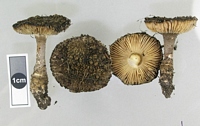|
 Amanita inopinata Amanita inopinata
SynonymsAmanita sp. 1
BiostatusPresent in region - Exotic
Images (click to enlarge)
Owner: J.A. Cooper |
Article: Ridley, G.S. (1991). The New Zealand species of Amanita (Fungi: Agaricales). Australian Systematic Botany 4(2): 325-354.
Description: Basidiocarps medium, solitary. Pileus 50-85 mm, convex to plano-convex, then plano- depressed, greyish sepia to fuscous, volva remnants consisting of blunt, pyramidal warts to 1.5 mm high, or scab-like scales, which become smaller and floccose towards pileus margin, fuscous and occasionally with pale edges. Lamellae crowded, free, 6-9 mm wide, white then 'creamy white', possibly with 'pale pink' to 'pale apricot' tints; lamellulae truncate. Stipe 38-80 mm high, 4-20 mm diameter, solid, clavate, with rounded to slightly radicating base, surface above annulus powdery, striate, 'greyish' to 'lilac grey', below annulus apically free, 'dark grey' fibrils, or volva remnants forming bands, base white to sordid white. Context of pileus white and 'grey' beneath pellis, stipe white or turning slightly 'yellowish' or 'apricot' on exposure.
Spore print 'creamy'. Basidiospores (42/3), (7.5-)8-9(-10) x (5.5-)6-7.5(-8) µm, Qm 1.31, Q (1.12-)1.20-1.50, occasionally subglobose, usually broadly ellipsoid, hyaline, amyloid. Basidia not observed, however hymenial elements 29-35. 5 x 9-10.5 µm, clamped. Lamella margin cells absent. Volva remnants from pileus consisting of abundant, globose, ellipsoid, clavate, umber cells, 51-166 x 17-58 µm, with hyphae to 13 µm wider 'clamped, elements vertically orientated to pileipellis.
Article: Ridley, G.S. (1991). The New Zealand species of Amanita (Fungi: Agaricales). Australian Systematic Botany 4(2): 325-354.
Description: Basidiocarps medium, solitary. Pileus 50-85 mm, convex to plano-convex, then piano- depressed, greyish sepia to fuscous, volva remnants consisting of blunt, pyramidal warts to 1.5 mm high, or scab-like scales, which become smaller and floccose towards pileus margin, fuscous and occasionally with pale edges. Lamellae crowded, free, 6-9 mm wide, white then 'creamy white', possibly with 'pale pink' to 'pale apricot' tints; lamellulae truncate. Stipe 38-80 mm high, 4-20 mm diameter, solid, clavate, with rounded to slightly radicating base, surface above annulus powdery, striate, 'greyish' to 'lilac grey', below annulus apically free, 'dark grey' fibrils, or volva remnants forming bands, base white to sordid white. Context of pileus white and 'grey' beneath pellis, stipe white or turning slightly 'yellowish' or 'apricot' on exposure.
Spore print 'creamy'. Basidiospores (42/3), (7.5-)8-9(-10) x (5.5-)6-7.5(-8) µm, Qm 1.31, Q (1.12-)1.20-1.50, occasionally subglobose, usually broadly ellipsoid, hyaline, amyloid. Basidia not observed, however hymenial elements 29-35. 5 x 9-10.5 µm, clamped. Lamella margin cells absent. Volva remnants from pileus consisting of abundant, globose, ellipsoid, clavate, umber cells, 51-166 x 17-58 µm, with hyphae to 13 µm wider clamped, elements vertically orientated to pileipellis.
|